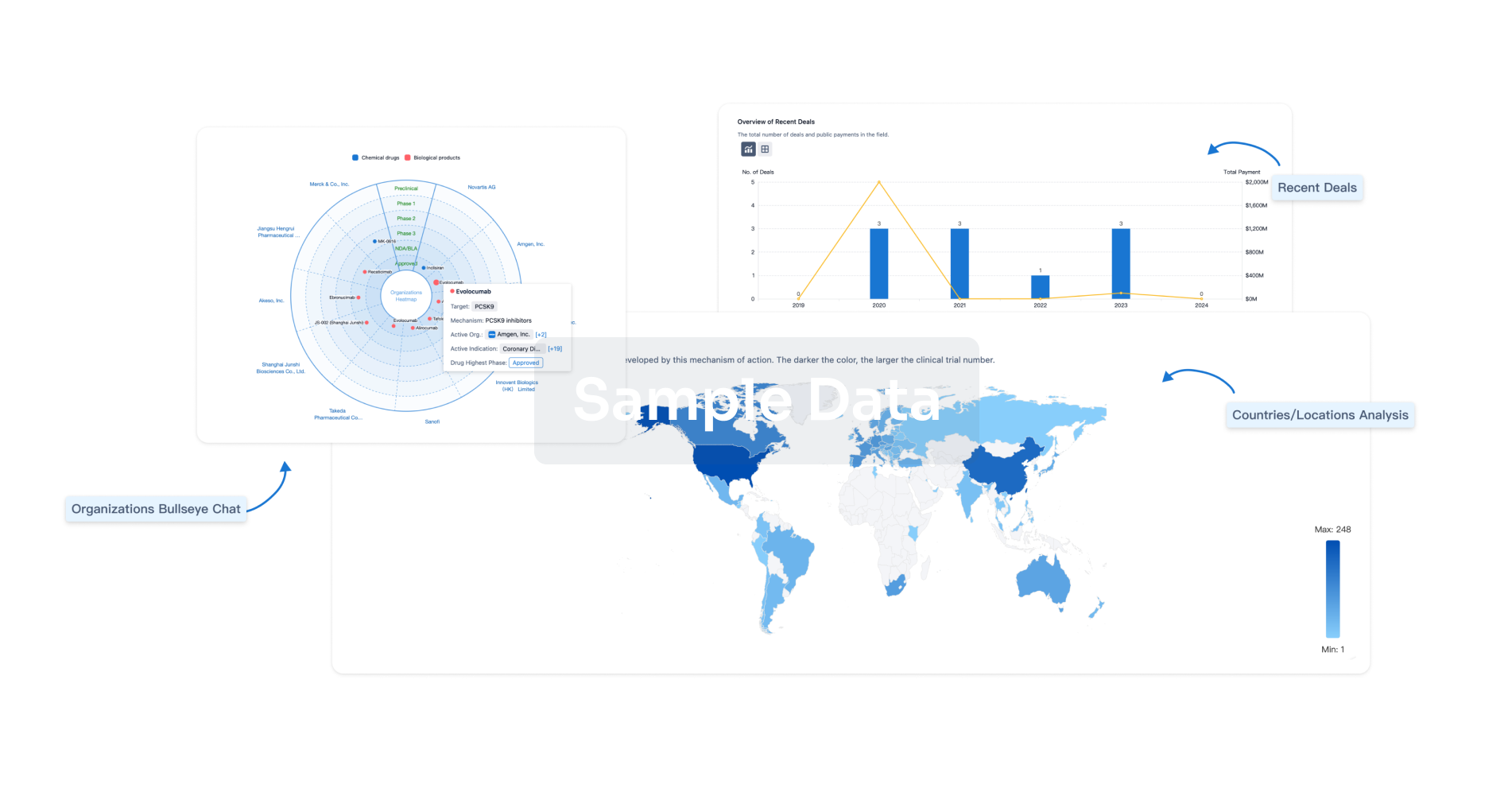Request Demo
Last update 03 Oct 2024
ZC4H2
Last update 03 Oct 2024
Basic Info
Related Targets |
Related
100 Clinical Results associated with ZC4H2
Login to view more data
100 Translational Medicine associated with ZC4H2
Login to view more data
0 Patents (Medical) associated with ZC4H2
Login to view more data
80
Literatures (Medical) associated with ZC4H201 Sep 2024·PEDIATRIC NEUROLOGY
Genotype-Phenotype Correlations and Sex Differences in ZC4H2-Associated Rare Disorder
Article
Author: Mandalapu, Shreya ; Dickinson, Carolyn ; Carrier, Ryan ; Nguyen, Ashlie ; Peters, Sydney ; Paciorkowski, Alex ; Bearden, David ; Sportiello, Kristen
BACKGROUND:
ZC4H2-associated rare disorder (ZARD) is caused by pathogenic variations in the ZC4H2 gene on the X chromosome. This gene codes for a zinc finger protein involved in neural development. ZARD is characterized by highly variable symptoms, potentially influenced by the sex of the individual.
METHODS:
The ZC4H2-Associated Rare Disorder Natural History Study is a prospective natural history study conducted among individuals with ZARD that consists of standardized interviews, developmental assessments, and neurological examinations conducted every six months for two years. In this article, we present data from baseline visits with 40 participants, the largest ZARD cohort studied thus far, focusing on genotype-phenotype correlations and sex differences. Fisher exact, maximum likelihood χ2, and Mann-Whitney tests were utilized.
RESULTS:
Males tended to have maternally inherited ZC4H2 pathogenic variations, whereas females tended to have de novo variations (P < 0.001). Female participants were more likely to have contractures at birth (P < 0.01), arthrogryposis multiplex congenita (P < 0.001), spasticity on examination (P < 0.1), and lower limb muscle atrophy (P < 0.05). Male participants were more likely to have seizures (P < 0.1), intermittent pain (P < 0.01), severe vision impairment (P < 0.05), dysphagia for solids (P < 0.01), and generalized muscle atrophy (P < 0.05).
CONCLUSIONS:
Our study suggests there is significant overlap in severity and range of symptoms between males and females, although several symptoms are more common in one sex than the other. Further analysis is needed to better understand how pathogenic variation type affects phenotype.
01 Jan 2024·The Tohoku journal of experimental medicine
Treatment of <i>ZC4H2</i> Variant-Associated Spastic Paraplegia with Selective Dorsal Rhizotomy and Intensive Postoperative Rehabilitation: A Case Report
Article
Author: Takayama, Jun ; Takahashi, Yuko ; Inui, Takehiko ; Komatsu, Shigemasa ; Asato, Takashi ; Haginoya, Kazuhiro ; Ochiai, Tatsuhiro ; Saijo, Naoya ; Yoshida, Ayuko ; Otomo, Misaki ; Suzuki, Makoto ; Tamiya, Gen ; Kinjo, Takeshi ; Morishita, Yuko ; Okubo, Yukimune ; Inotani, Toshiki ; Kikuchi, Atsuo ; Horaguchi, Akira ; Mizuno, Chika
Selective dorsal rhizotomy (SDR) has been used to treat children with spastic cerebral palsy (CP), and its beneficial effect on quality of life and ambulation has been confirmed in long-term follow-up studies. However, the role of SDR in the treatment of spasticity in patients with hereditary spastic paraplegia (HSP) and related disorders is not well-established. Here, we report the first patient with the ZC4H2 variant who underwent SDR to treat spastic paraplegia. Abnormal gait was discovered during a regular checkup at the age of 3 years and 9 months, and she was diagnosed with spastic paraplegia. She was heterozygous for the ZC4H2 variant and underwent SDR at the age of 5 years and 11 months, which alleviated the spasticity. The patient underwent inpatient postoperative rehabilitation for 4 months and continued outpatient physiotherapy after discharge. The Gross Motor Function Measure-88 score and maximum walking speed decreased transiently 1 month postoperatively, but gradually recovered, and continuously improved 6 months postoperatively. SDR and postoperative intensive rehabilitation were effective in improving motor and walking functions up to 6 months after surgery, although long-term follow-up is needed to draw conclusions.
01 Oct 2023·Ophthalmic genetics
Optic nerve abnormalities in female-restricted Wieacker-Wolff syndrome by a novel variant in the ZC4H2 gene.
Article
Author: Martínez-de-Villarreal, Laura E ; Mohamed-Noriega, Jibran ; Rodríguez-Garza, Claudia ; DeLagarza-Pineda, Oscar ; Fernandez-de-Luna, Marissa L ; Ibarra-Ramírez, Marisol ; Arenas-Estala, Joel ; Campos-Acevedo, Luis D
BACKGROUND:
Wieacker-Wolff syndrome is an ultra-rare disease with X-linked inheritance characterized by arthrogryposis, intellectual disability, microcephaly, and distal limb muscle atrophy. Ophthalmic abnormalities such as ptosis, strabismus, and oculomotor apraxia have been reported in half of the patients. Wieacker-Wolff syndrome female-restricted (WRWFFR) is an even rarer disease recently used for females with a more severe phenotype.
MATERIALS AND METHODS:
Clinical geneticist and ophthalmic examination, neuroimaging, and exome sequencing.
RESULTS:
A 4 years-old girl with developmental and language delay, microcephaly, camptodactyly, digital pads, and arthrogryposis was identified by the clinical geneticist. Ophthalmic examination revealed deep-set eyes, high hyperopic astigmatism in both eyes, and reduced retinal nerve fiber layer thickness measured by optical coherence tomography. Exome sequencing identified a novel, probably pathogenic variant in the ZC4H2 gene NM_018684.3:c.145A>T p. (Lys49*) in heterozygosis.
DISCUSSION:
WRWFFR is an ultra-rare disease with X-linked inheritance by variants in the ZC4H2 gene. This case reports a girl with a novel nonsense variant in the ZC4H2 gene and a severe phenotype; previous reports have identified WRWFFR in females with large deletions and nonsense mutations which could explain the manifestations in the current case report. A complete ophthalmic examination should be considered in patients with WRWFFR to detect the possibly associated optic nerve involvement and other previously described manifestations such as ptosis and strabismus.
Analysis
Perform a panoramic analysis of this field.
login
or

AI Agents Built for Biopharma Breakthroughs
Accelerate discovery. Empower decisions. Transform outcomes.
Get started for free today!
Accelerate Strategic R&D decision making with Synapse, PatSnap’s AI-powered Connected Innovation Intelligence Platform Built for Life Sciences Professionals.
Start your data trial now!
Synapse data is also accessible to external entities via APIs or data packages. Empower better decisions with the latest in pharmaceutical intelligence.
Bio
Bio Sequences Search & Analysis
Sign up for free
Chemical
Chemical Structures Search & Analysis
Sign up for free